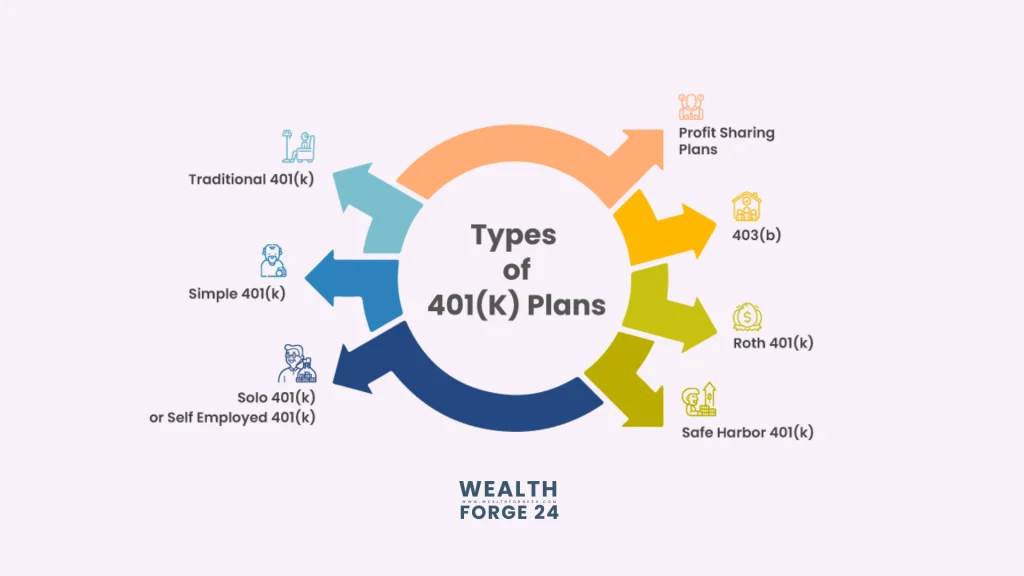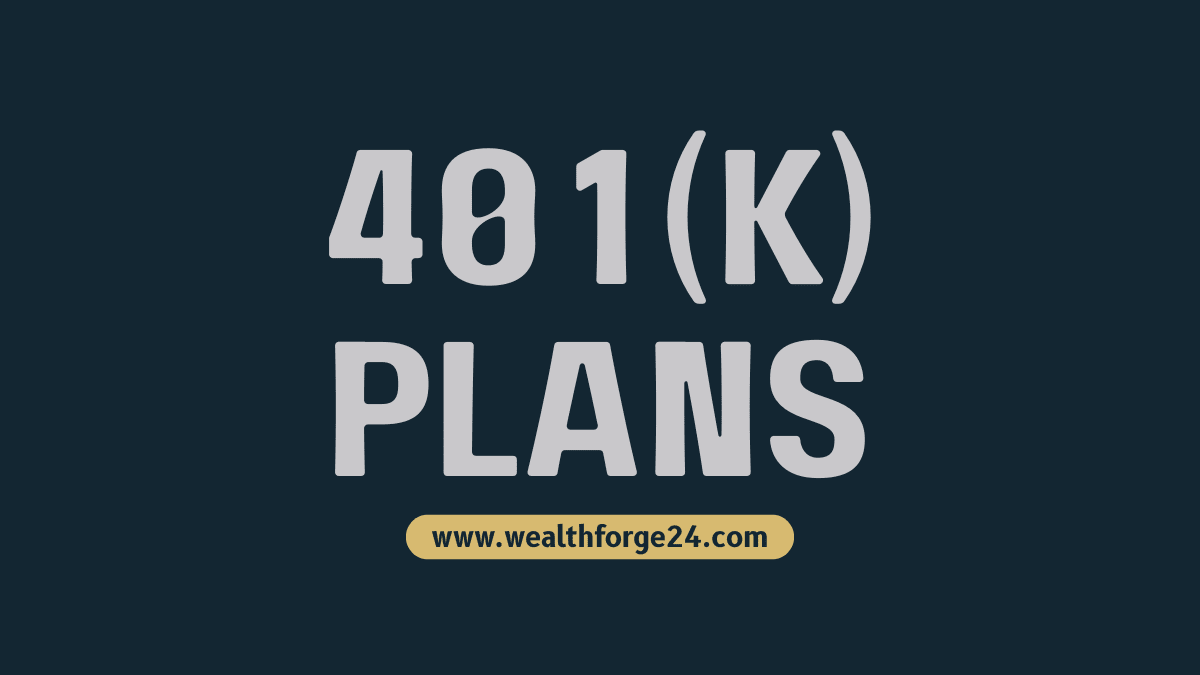What Is a 401(ok) Strategy?
A 401(k) Plans Explained: What They Are and How They Work plan is a tax-advantaged retirement financial savings plan. The 401(k) is a defined-contribution plan. It gets its name from a section of the U.S. Internal Revenue Code. Companies offer it to employees. The enterprise may go worker contributions; with some plans, the match is mandatory.
There are 2 major sorts of 401(k): conventional and Roth. With a standard 401(k), worker contributions are pretax. This lowers your taxable income, but you’ll pay taxes on withdrawals during retirement. With a Roth 401(k), worker contributions are made with after-tax revenue. There’s no tax deduction within the charge 12 months, but withdrawals– expert circulations– are tax free.
Here’s a guide on how the 401(k) process works. You’ll learn how to start one and tips for maximizing your plan.
Key Takeaways
- A 401(ok) plan is a company-backed pension in which people can add a percent in their profits. Companies usually deliver to suit at least numerous of these bills.
- There are two essential sorts of 401(ok)– traditional and Roth– which vary specifically in just how they are taxed.
- Employers can contribute to both general and Roth 401(k) plans. Solo 401(k) plans are available for those without employers.
- There are guidelines governing when you can take out cash from a 401(k) without penalty.
Expert Insight: “One of the most crucial factor to understand while making any type of desire concerning your 401(ok) is to make use of it. “A good globe shows the best amount, but you need to add where your employer fits in,” said Peter Lazaroff, a financial advisor and chief investment officer at Plancorp.
401(k) Participation Statistics
In 2023, Americans saved a median of 7.1% of their wages in 401(k)s. This was higher than the overall personal savings rate for that year. Less than 12% of running-age Americans were given on the right track in 2023 to max out their contributions.
2025 Contribution Limits
The 401(k) worker contribution limit for 2025 is $31,000 for those 50 and older. This includes “catch-up” contributions. For workers under 50, the limit is $23,500.
How 401(k) Plans Work
Conventional 401(k) techniques began in the early 1980s. They let workers make pretax contributions from their salaries, up to certain limits.
When an employee signs up for a 401(ok), they take delivery of switch a percent of every income instantly proper into an funding account. Employers generally match component or every one among that contribution.
Workers pick specific financial investments for their 401(k) accounts from options offered by their company. Usually, funding services consist of deliver and bond mutual budget and target-date finances created to minimize the chance of losses as the employee methods retired existence.
Note: A workforce member’s account may also have guaranteed financial contracts from the insurer and sometimes the organization’s own stock.
How Do You Beginning a 401(k)?
Step 1: Contact Your Employer
Get in contact together with your organization. Ask if a 401(k) is to be had, and whether there’s a business fit. Some employers will make this clear whilst you’re hired.
Step 2: Subscribe
If a 401(k) is obtainable, the corporation will train you on the way to subscribe.
Step three: Select Your Investments
Select your investments. There should be lots of picks, from conservative to adverse. A popular choice is the goal date account, which immediately readjusts the assets mix to line up with a predetermined retirement date. It normally involves be plenty greater conventional as you near retirement.
Solo 401(k) for Self-Employed
If you’re a freelancer or run a small business with your partner, you might qualify for a solo 401(k) plan, also called an independent 401(k). These techniques enable unbiased experts to cash their personal retired existence. A solo 401(ok) can be developed with a variety of on line agents.

Traditional 401(k)s: Understanding Pretax Contributions
How Traditional 401(k)s Work
With an average 401(k), employee payments are deducted from gross income. This suggests the coins comes out of your paycheck previous to profits tax responsibilities have genuinely been subtracted.
Your taxable income is lowered by your full contributions for the year. This can reduce your tax bill for that year. No tax duties are due on your contributed economic investment income until you withdraw the coins, usually in retirement.
Roth 401(k)s: After-Tax Contributions Explained
The History of Roth 401(k)s
When 401(k) plans began in the 1980s, companies and their workers wanted one thing: the standard 401(k). Roth 401(ok)s failed to show up until 2006. These 401(ok) plans are named after William Roth, a former U.K. Senator from Delaware. He was the main sponsor of the 1997 law that created the Roth IRA. In the beginning, Roth 401(k)s stuck on progressively, now many businesses supply them.
How Roth 401(ok)s Work
With a Roth 401(k), contributions are deducted out of your after-tax profits. This suggests you contribute out of your pay after profits taxes were subtracted. Consequently, there is no tax reduction in the year of the fee. When you withdraw the cash throughout retirement, though, you don’t want to pay any type of additional taxes for your fee or on the funding profits.
Choosing Between Traditional and Roth
People who think they’ll be in a lower tax bracket when they retire might want to select a preferred 401(k). This choice allows them to take advantage of immediate tax savings.
Retiring workers might choose a Roth 401(k). This helps them avoid taxes on their savings later. This desire is worthwhile if the Roth has several years to grow. All the coins from payments over decades will be tax-free when withdrawn.
A Roth can cut your immediate costs more than a regular 401(k) plan. This is important to think about if your budget is tight.
Important: Contributions to a Roth 401(k) come from after-tax cash. However, if you withdraw funds before age 59 and a half, there may be tax consequences. Before taking cash from a Roth or traditional 401(k), talk to an accounting expert or a certified financial consultant.
401(k) Plan Payment Restrictions
Standard and Roth 401(ok) strategies are targeted payment plans. Both the worker and the agency can contribute to the account, up to the dollar limits set by the IRS.
The maximum an employee or corporation can contribute to a 401(k) plan changes from time to time. This adjustment reflects the rising cost of living, which affects increasing expenses.
2025 Contribution Limits
For 2025, the yearly trouble on employee contributions to a 401(ok) is $23,500 for employees underneath age 50. Those age 50 or older could make an extra $7,500 catch-up contribution.
Tip: “Even though everyone has different situations, you should aim to contribute the maximum allowed to your 401(k),” says Peter Lazaroff, a top financial expert at Investopedia.
Company Matching Contributions
Combined Limits
For people under 1/2 a century antique, the blended drawback for both employee and business enterprise payments is $70,000 every 12 months in 2025. If the trap-up fee for those 50 or older is consisted of, the combined quandary is $seventy seven,500.
How Employer Matching Works
Companies that suit worker contributions utilize severa solutions to compute that fit. An corporation might suit $zero.50 for every $1 that the worker contributes, as an instance, as a whole lot as a selected percentage in their salary. Lead estimates that about one in seven agencies offer 401(k) matching. This typically matches 6% of their employees’ salaries.
Expert Advice on Matching
Lazaroff, host of the investment podcast The Long-term Financier, says to use your company’s matching contributions if you can. It’s a risk-unfastened technique to develop your cash and not depart a part of your repayment on the desk.
“Meeting the suit doesn’t mean you have to give up other money goals, like paying off debt or building an emergency fund,” he says. “You can nonetheless attempt monetary debt and positioned away possibilities in a reserve if vital. But shielding that business enterprise match is critical.”
Exactly How Does Your 401(ok) Generate earnings?
Investment Options
When you contribute to your 401(k), your money is invested based on your choices from your company’s options. These generally consist of an collection of goal-date finances and mutual finances.
Target-Date Funds
Target-date finances are the approach “you’re least most likely to make errors,” Lazaroff claimed. These accounts mix components, bonds, and various protections. They adjust as your target date approaches. Typically, they shift toward more conservative investments as you near retirement.
“You may be different from the average, and you might accumulate ok wealth one day wherein a goal-date fund isn’t always one of the maximum perfect. “But for many people, it’s often one of the simpler and lower-risk courses to take,” Lazaroff says.
Growth Factors
Many factors influence how fast and how much your 401(k) grows. These factors include your yearly contributions, any company matches, investment performance, and the time until retirement.
Tax-Deferred Growth
A extensive gain of a 401(k) is tax-deferred increase. With a stylish 401(k), you avoid paying taxes on investment gains, interest, or dividends until you withdraw money from the account. With a Roth 401(k), you might not have to pay taxes on qualified withdrawals in retirement. This is because contributions are made with after-tax dollars.
The Power of Compounding
Opening up a 401(ok) also allows your coins to develop in time, way to the energy of intensifying. Intensifying happens when the returns from your savings are reinvested into the account. This generates new returns on top of the original ones. Over years, the compounded profits in your 401(k) account can exceed the quantity you contributed. This is why, as you continue to add in your 401(k), it may grow as a substitute substantially by the point you retire.
401(k) Withdrawals: Rules and Considerations
Accessibility Limitations
As quickly as your coins goes into a 401(k), it is able to be hard to withdraw it with out paying tax duties on the quantity.
“Make sure you still have enough saved for emergencies and costs before retirement,” says Dan Stewart, head of Dallas-based Revere Asset Management. “Do no longer put all of your value financial savings into your 401(ok) where you can’t effortlessly accessibility it, if required.”
Emergency Fund Recommendations
For savings, consider putting some of your money into a high-yield savings account. This way, you can access it quickly while earning good interest. And for cash you will not require for some time, consider the very great simply available CDs to stable a robust charge for months or years right now.
Tax Implications
Profits in a 401(ok) account are tax-deferred for conventional 401(k) money owed and tax-unfastened for Roth accounts. When you withdraw from a conventional 401(k), that money (which has virtually in no way been tired) will be tired as regular earnings. With a Roth, you have got certainly already paid income tax at the cash you introduced, so that you may not owe taxes on withdrawals if you please information requirements.
Withdrawal Rules
You must visit at least fifty-nine and a half or meet IRS requirements for a hardship withdrawal. If you withdraw early, you’ll face a 10% penalty plus any income tax you owe.
Rapid Truth: Some corporations permit employees to obtain a mortgage versus their 401(ok) plan contributions, basically borrowing from themselves.
Needed Minimum Distributions (RMDs)
Standard 401(k) account owners must take required minimum distributions (RMDs) after reaching a certain age. If they don’t, they risk an IRS penalty. (Withdrawals are called circulations in inner sales carrier parlance.)
RMD Age Requirements
Investors who have actually retired need to begin taking RMDs from their 401(ok) intends at age seventy three. The amount of the RMD is decided based on your existence expectancy on the time. Before 2020, the RMD age become 70 1/2. Afterwards, it became changed to 72. And it changed into up to date to age seventy three within the omnibus spending cost H.R. 2617 in 2022.
What Are the Benefits and downsides of a 401(k)?
Pros
- Conventional 401(k) prepares allow you minimize your tax duty burden at the same time as saving for retirement.
- With Roth 401(k)s, certifying withdrawals are tax free.
- Tax-deferred gains.
- Easy for the reason that payments are instantly subtracted out of your paycheck.
- Company may want to provide a match, improving your retirement cost savings.
Cons
- 401(k)s can include charges– although they’re typically modest.
- Standard (no longer Roth) money owed go through called for minimal distributions (RMDs).
- If you withdraw funds early, there are costs. If you’re under 59 and a half and don’t qualify for an exception, you’ll face a 10% penalty from the IRS.
- A 401(k) could not be enough by way of itself to keep you in retired existence, relying on your targets and occasions. Consider speaking with a monetary professional who can stroll you thru other choices.
Tip: Since it’s hard to predict tax charges decades ahead, many financial advisors suggest putting money into both Roth and regular 401(k) accounts.
History of the 401(ok)
The Shift in Retirement Savings
The United States has changed a lot in how Americans shop for retirement. Our chart shows the different types of retirement plans. It includes numbers for millions of Americans in both advantage and contribution plans, along with the total amounts for each.
Defined Contribution vs. Defined Benefit Plans
Specified price strategies, the bulk of which can be 401(ok)s, are an option to the traditional pension, known as a special advantage strategy. With a 401-k, the company is committed to offering a details sum of money to the employee for lifestyles at some stage in retired lifestyles. In recent years, as shown in the graph below, payment plans like 401(k)s have become more common. Traditional pensions are now rare. Employers have shifted the responsibility and risk of saving for retirement onto individuals.
Current Statistics
Originally, employers used 401(k)s to add to other benefits. They are now the most popular retirement plan sponsored by companies in the U.S. About one in three working-age Americans have a 401(k), based on U.S. demographic data. This compares to just one in nine who have a defined benefit pension. At the identical time, as masses of as 4 in 10 infant boomers and 1/2 of millennials have no pension in all.
Advantages and Flexibility
Still, the 401(k) plan was designed to encourage Americans to shop for retired life. Among its benefits are tax obligation financial savings. If your enterprise gives each kinds of 401(ok) plans, you could cut up your contributions, placing some cash right into a traditional 401(ok) and a few right into a Roth 401(ok).
401(k)s vs. Brokerage Accounts
Understanding the Differences
Both broking agent accounts and 401(k) debts are types of investment accounts. However, they serve different purposes. A 401(k) is mainly for retirement savings. A brokerage account, on the other hand, serves various financial goals and offers more control over investments.
401(k) Characteristics
A 401(ok) is a form of equipped retirement plan. You can choose from a variety of funding options (usually mutual funds) where your money grows in a tax-friendly way.
Brokerage Account Characteristics
A brokerage corporation account is a personal account. You can buy, sell, and hold various securities through it. This includes mutual funds, stocks, bonds, and exchange-traded funds (ETFs). Brokerage accounts are taxed. This means your earnings from investments and dividends are subject to tax today. There are additionally no payment regulations, very early withdrawal issues, or minimal circulations.
Comparison Table
401(k):
- Retirement account
- Employer-sponsored
- Minimal meals choice of funding picks
- Tax-deferred
- Yearly contribution regulations
- Early withdrawal charges
- RMDs
- Potential for organisation matching
Brokerage company Account:
- Can be used for whatever
- Self-sponsored
- Can purchase or offer any monetary funding
- Taxed
- No charge limits
- No withdrawal penalties
- No RMDs
- No organization matching
What Takes vicinity to Your 401(k) When You Leave a Work?
When you leave a commercial enterprise wherein you’ve been employed and you’ve a 401(k) plan, you generally have four alternatives:
1. Withdraw the Cash
Withdrawing the coins is usually a terrible concept unless you speedy need it. The cash could be taxed for the 12 months it’s withdrawn. You may face a 10% early withdrawal tax until you turn 59 and a half, become fully disabled, or meet other IRS exemption criteria.
With a Roth 401(k), you can withdraw your contributions tax-free and without penalty after five years. You can also do this if you meet the IRS criteria mentioned earlier. However, you’re nonetheless reducing your retirement cost savings, that you might be sorry for later on.
2. Roll Your 401(k) Into an individual retirement account
Moving cash into an individual retirement account (IRA) at a brokerage or financial group helps avoid immediate taxes. This keeps the account’s tax-advantaged status intact. You can also pick from a wider range of funding options than you had with your corporation’s method.
The inner revenue provider has highly stringent rules on IRA rollovers and precisely how they need to be finished. Not following them is high priced. Usually, the banks in line to obtain the cash will definitely assist with the process to prevent any awful movements.
Caution: Funds withdrawn from your 401(okay) needs to be surrendered to an additional pension inside 60 days to live clean of tax obligations and penalties.
three. Leave Your 401(ok) With Your Former Company
Employers often let departing employees keep their 401(k) accounts in the old plan. However, those employees can’t make any more contributions. This normally relates to debts really worth at least $five,000. For smaller money owed, a enterprise may offer the worker no choice but to move the coins someplace else.
Keeping the cash where it is makes sense if the previous company’s plan is well-managed and you trust its investment choices. The threat is that team of workers participants that remodel jobs all through their careers can leave a path of antique 401(k) strategies and can forget numerous of them. Their successors will also be uninformed of the presence of the accounts.
Capitalize, a funding platform for forgotten 401(k) accounts, estimates that in 2023, nearly 30 million such accounts existed in the U.S. These accounts hold about a quarter of all Americans’ wealth in 401(k) plans.
4. Relocate Your 401(k) to Your New Employer
You can generally relocate your 401(ok) stability to a emblem-new agency’s plan. Similar to an IRA rollover, this preserves the account’s tax-deferred standing and prevents spark off taxes.
If you aren’t relaxed with coping with a rollover, you can depart several of the work to the emblem-new plan’s manager.
Frequently Asked Questions (FAQ)
What Is the Optimum Payment to a 401(k)?
The most price to a 401(ok) strategy is $23,500 in 2025 if you are greater youthful than half a century vintage. If you’re 50 years vintage or older, you may make a further trap-up payment of $7,500. There are limits on the business’s matching price. In 2025, total contributions from the business and employees can’t exceed $70,000 for those under 50. For workers aged 50 and older, the limit is $77,500.
Is It an Excellent Idea to Take Very Early Withdrawals From Your 401(k)?
Usually, no. There are few advantages to taking an early withdrawal from a 401(k) method. If you withdraw previous to age 59 half, you may face a ten% penalty further to any form of tax obligations you owe. However, a few employers permit problem withdrawals for unexpected economic demands, which includes specific clinical expenses, funeral charges, or getting a domestic. This can aid you stay clean of the early withdrawal penalty, however you will truely still want to pay taxes at the withdrawal.
Exactly How Can a Stock Sell-Off Effect Your 401(k)?
A change in diving inventory might seem concerning, but it’s often the right move to make. In the middle of a large stock sell-off (a bearish market), components are essentially on fee reduce, if you could climate a few huge feelings and forget outside pressure. Though the well worth of your 401(k) will dip as the marketplace dips, it is maximum possibly that it won’t permanently– or maybe for too lengthy.
All-time Low Line
A 401(k) plan is a workplace retirement option. It lets you make yearly contributions up to a set limit. You can use this money in your later years.
There are 2 full-size styles of 401(k) plans: standard and Roth. The traditional 401(k) involves pretax contributions that offer you a tax duty smash whilst you lead them to and reduce your gross income. Nevertheless, you pay regular revenue tax responsibility for your withdrawals. The Roth 401(k) involves after-tax payments. There’s no early tax hit. So, you likely won’t owe taxes on your withdrawals in retirement. Both accounts allow organization payments that can beautify your monetary financial savings.
Sources :
- fidelity.com | What’s a 401(k)?
- irs.gov | 401(k) plans
- investopedia.com | 401(k) Plans : What Are They, How They Work
For expert economic guidance and retirement planning, visit WealthForge24. They are your trusted partner for building wealth and securing your financial future.








